Sold Ceramics
Sold Japanese Imari 1690-1800
Dishes
Page 2
When internal wars began to impede the production of, and consequently the trade in, Chinese porcelain toward the end of the Ming Dynasty (1368-1644), several Dutch Merchants began to buy porcelain in Japan. At the same time, the production of faience pottery in Delft was stimulated, in order to compensate the shortage of Chinese porcelain. From 1658 onward, the Dutch East India Company, (Vereenigde Oost-Indische Compagnie, VOC) also recognized these commercial opportunities and began to order greater quantities of porcelain from Japan. In addition to a very diverse assortment of blue-and-white porcelain. largely in the style of traditional Chinese export goods, the coloured Japanese porcelain formed an unexpected new article in the Netherlands. It soon became very fashionable and the Company was able to generate a great deal of profit in this field.
One potter who benefited greatly from the new Dutch orders was Sakaida Kakiemon, who owned a porcelain kiln near Nangawara, just outside Arita. His porcelains characterized by a lucid whit composition and texture with decorations in various tints of enamel including orange-red, grass-green and blue.
By the second half of the 17th century, this porcelain had already seen the rise of a serious rival, the so-called Imari porcelain, named after the port in Kyushu from which it was shipped. This Imari was cheaper, and had vibrant, full decoration in cobalt blue, orange-red and gold, occasionally with extra details in green enamel, aubergine or black. It was manufactured specifically for export and harmonized perfectly with the baroque taste of the buyers in the Netherlands. It became so popular that the Chinese also began to produce it from the 18th century onward.

Sold Ceramics - Sold Japanese Imari 1690-1800 - Dishes - Page 2
Object 2012343
Dish
Japan
1700-1720
Height 53 mm (2.09 inch), diameter: 295 mm (11.61 inch), diameter of footring: 142 mm (5.59 inch), weight 1,033 grams (36.44 ounce (oz.))
Dish on footring, spreading flat rim. On the base four spur-marks in a Y-pattern. Imari, decorated in underglaze blue, iron-red, green and gold. In the centre a roundel with a flower vase filled with flowering branches and four roundels filled with butterflies and bees and surrounded by a an upturned leaf shape-pattern. The sides with a ground of dense leafy scrolls in underglaze blue outlined in gold. Overlapping four large shaped panels alternating with four small shaped panels all filled with flower sprays. Groups of pomegranates alternate with groups of flowering chrysanthemum. On the reverse three wide spread chrysanthemum sprays. (Jörg 2003/1, pp.91-92)
The Imari style developed somewhere between 1670 and 1690, undoubtedly stimulated by the orders from the Dutch who liked the bright colours, the strong designs and the complex compositions. 'They got a of lot of decoration for their money', a collector once remarked and I think it was this, too, that appealed so much to buyers of Imari in The Netherlands and elsewhere in Europe. In fact, the Imari style conformed to the fashion for polychromy and gilt-work in Europe at the time. The 17th century was ' The Golden Age' for The Netherlands. It was a period of great economic and cultural expansion and its impact was felt well into the 18th century. The richly decorated Imari pieces fitted perfectly into the baroque interior and appealed to the taste of the rich bourgeoisie, enhancing their social status.
Condition: Some wear to the decoration and some popped bubbles of glaze, caused by the firing process, to the rim.
Reference:
Price: € 899 Currency Converter
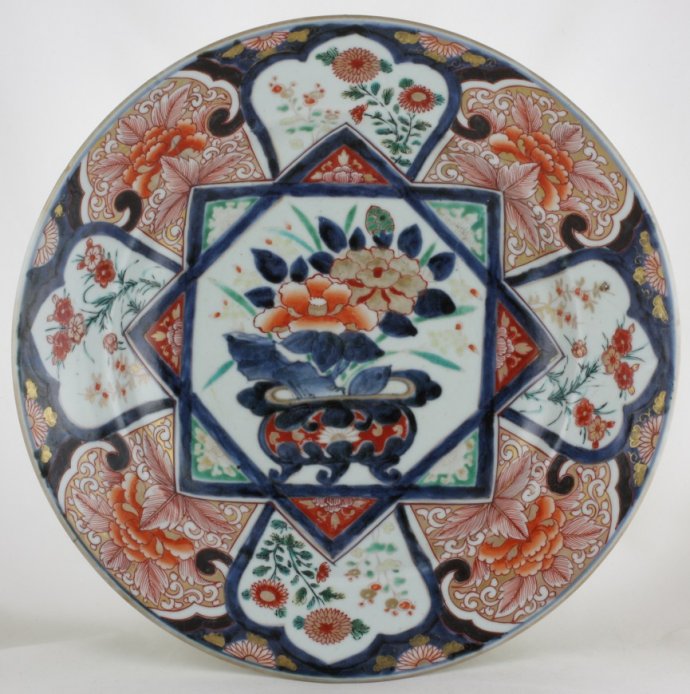
Sold Ceramics - Sold Japanese Imari 1690-1800 - Dishes - Page 2
Object 2012289
Dish
Japan
1700-1720
Height 70 mm (2.76 inch), diameter 358 mm (14.09 inch), diameter of footring 170 mm (6.69 inch), weight 1,961 grams (69.17 ounce (oz.))
Dish on footring, flat rim. On the base five spur-marks. Imari, decorated in underglaze blue, iron-red and gold with two superimposed shikishi filled with a flowerpot with flowering peony plants. On the sides and rim shaped panels filled with various flowering plants alternating with a flower head with leaves and leafy scrolls. On the base a shop or painters mark in underglaze blue. The reverse is undecorated.
The superimposed squares represent shikishi, special Japanese papers used for painting or calligraphy. This shikishi pattern was originally used in Japan as a decoration design on moulded dishes with scalloped rims. (Jörg 2003/1, p.38, cat. 21)
In his Fine & Curious on page 40, cat. 22 Jörg shows an example of this shikishi design pattern.
Reproduced from: Fine & Curious. Japanese Export Porcelain in Dutch Collections, (C.J.A. Jörg, Hotei Publishing, Amsterdam, 2003), p.40, cat. 22. This dish is not included in this sale/offer. (copyright in bibliographic data and images is held by the publisher or by their respective licensors: all rights reserved)
For examples of dishes decorated with this shikishi design pattern, please see:
- Fine & Curious. Japanese Export Porcelain in Dutch Collections, (C.J.A. Jörg, Hotei Publishing, Amsterdam, 2003), pp.38-40, cat. 21 & 22.
- Complete Catalogue of the Shibata Collection, (The Kyushu Ceramic Museum, Kyushu 2003), p.132, cat. 997 & 998.
Apparently the same shikishi design pattern was used on Delftware of c.1660-1680 proving that Japanese pieces with this design pattern were known in The Netherlands at that time. (Jörg 2003/1, p.38, cat. 21a)
For an identically shaped and similarly decorated Dutch (Delftware) dish, please see;
- Fine & Curious. Japanese Export Porcelain in Dutch Collections, (C.J.A. Jörg, Hotei Publishing, Amsterdam, 2003), p.38, cat. 21a.
Condition: Restored, two hairlines and two re-stuck pices to the rim.
References:
Jörg 2003/1, cat. 21, cat. 21a & cat. 22
Price: Sold.

Sold Ceramics - Sold Japanese Imari 1690-1800 - Dishes - Page 2
Object 2012457
Dish
Japan
1700-1720
Height 32 mm (1.26 inch), diameter 283 mm (11.14 inch), diameter of footring 152 mm (5.98 inch), weight 817 grams (28.82 ounce (oz.))
Dish on footring, flat rim. On the base six spur-marks. Imari, decorated in underglaze blue, iron-red, gold and green, black, aubergine overglaze enamel with two superimposed shikishi filled with a chilon (sea-dragon). On the sides and rim shaped panels filled with a shishi alternating with Hó-ó birds in flight. In between the panels scrollwork in gold on an underglaze blue ground with a chrysanthemum flower heads in iron-red. On the reverse two wide spread chrysanthemum flower sprays.
The superimposed squares represent shikishi, special Japanese papers used for painting or calligraphy. This shikishi pattern was originally used in Japan as a decoration design on moulded dishes with scalloped rims. (Jörg 2003/1, p.38, cat. 21)
In his Fine & Curious on page 40, cat. 22 Jörg shows an example of this shikishi design pattern.
Reproduced from: Fine & Curious. Japanese Export Porcelain in Dutch Collections, (C.J.A. Jörg, Hotei Publishing, Amsterdam, 2003), p.40, cat. 22. This dish is not included in this sale/offer. (copyright in bibliographic data and images is held by the publisher or by their respective licensors: all rights reserved)
An identically shaped, sized and decorated dish is in the collection of oriental ceramics of the Groninger Museum, Groningen.
For examples of dishes decorated with this shikishi design pattern, please see:
- Fine & Curious. Japanese Export Porcelain in Dutch Collections, (C.J.A. Jörg, Hotei Publishing, Amsterdam, 2003), pp.38-40, cat. 21 & 22.
- Complete Catalogue of the Shibata Collection, (The Kyushu Ceramic Museum, Kyushu 2003), p.132, cat. 997 & 998.
Apparently the same shikishi design pattern was used on Delftware of c.1660-1680 proving that Japanese pieces with this design pattern were known in The Netherlands at that time. (Jörg 2003/1, p.38, cat. 21a)
An earlier sold identically shaped and similarly decorated Delftware of c.1660-1680 dish (object 2012203).
For an identically shaped and similarly decorated Dutch (Delftware) dish, please see;
- Fine & Curious. Japanese Export Porcelain in Dutch Collections, (C.J.A. Jörg, Hotei Publishing, Amsterdam, 2003), p.38, cat. 21a.
An earlier sold identically shaped and similarly Japanese Imari decorated dish (object 2012289).
Condition: Perfect with some firing flaws.
References:
Jörg 2003/1, cat. 21, cat. 21a & cat. 22
Price: Sold.

Sold Ceramics - Sold Japanese Imari 1690-1800 - Dishes - Page 2
Object 2012365
Dish
Japan
1700-1720
Height 40 mm (1.57 inch), diameter of rim 225 mm (8.86 inch), diameter of footring 135 mm (5.31 inch), weight 504 grams (17.78 ounce (oz.))
Dish on footring, straight rim. On the base three spur-marks. Imari, decorated in underglaze blue, iron-red, green, yellow and black enamel and gold with a stylized 12-petal chrysanthemum crest, (kiku no mon). The petals are decorated in gold and iron-red and gold reserved on an underglaze blue ground. Those in gold reserved on an underglaze blue ground show either a lozenge / diaper pattern (tasuki) or floral scrolls. Those in red and gold show designs of a flowering peony or a swastika / diaper pattern. The central decoration is surrounded by a continuous swirling clouds pattern border in iron-red. On the sides six reserves filled with a river scape alternating with a flowering chrysanthemum plant. in between the reserves half flower heads with leafy scrolls in gold on an underglaze blue ground. The reverse with three wide spread interlocking chrysanthemum sprays, round the outer footring a continuous swirling clouds pattern border in iron-red. On the base a single concentric band.
Although some types of chrysanthemum begin flowering in the summer, the chrysanthemum is primarily an indication of autumn. Like many autumn motifs the chrysanthemum evokes feelings of melancholy in Japan, as is beautifully expressed in a poem by the 9th-century Ki no Tomonori:
tsuyu nagara / to wear in my hair
arite kazasamu / I plucked a chrysanthemum
kiku no hana / with dew still clinging to it
aisenu aki no / oh may this present
hisashikarubeku / autumn's youth last forever
For dishes with a similarly large central chrysanthemum crest, (kiku no mon), please see:
- Mistrovská dĩla Japonského porcelánu / Masterpieces of Japanese Porcelain, (F. Suchomel, Prague 1997), p.145, cat. 197.
- Imari-Porzellan am Hofe der Kaiserin Maria Theresia, exhibition catalogue (Hetjens-Museum, Düsseldorf, 2000), p.83, cat. 58.
- Porzellan aus China und Japan. Die Porzellangalerie der Landgrafen von Hessen-Kassel, Staatliche Kunstsammlungen Kassel, Berlin 1990, p.518, cat. 286.
- Ko-Imari from the collection of Oliver Impey, (Barry Davies Oriental Art, London, 1997), pp. 200-201, cat. 119.
- Mistrovská dĩla Japonského porcelánu / Masterpieces of Japanese Porcelain, (F. Suchomel, Prague 1997), p.109, cat. 104 & p.128, cat 156.
- Japanese Export Porcelain. Catalogue of the Collection of the Ashmolean Museum, Oxford, (O. Impey, Hotei Publishing, Amsterdam, 2002), p.210, cat. 354.
- Fine & Curious: Japanese Export Porcelain in Dutch Collections, (C.J.A. Jörg, Hotei publishing, Amsterdam, 2003), p.117, cat.126 & p.197, cat. 247 & 247a.
- Complete Catalogue of the Shibata Collection, (The Kyushu Ceramic Museum, Kyushu 2003), p.356, cat. 2789.
For a dish with a similarly large central chrysanthemum crest, (kiku no mon), formerly part of the Dresden collection formed by Friedrich August or August the Strong, Elector of Saxony and King of Poland please see:
The crackled glaze is caused by the unequal contraction of the body and the glaze during cooling in the kiln after firing. (Jörg & Van Campen 1997, p.235)
Condition: Perfect.
References:
Suchomel 1997, cat. 104, 156 & 197
Jörg 2003/1, cat. 126, 247 & 247a
Price: Sold.
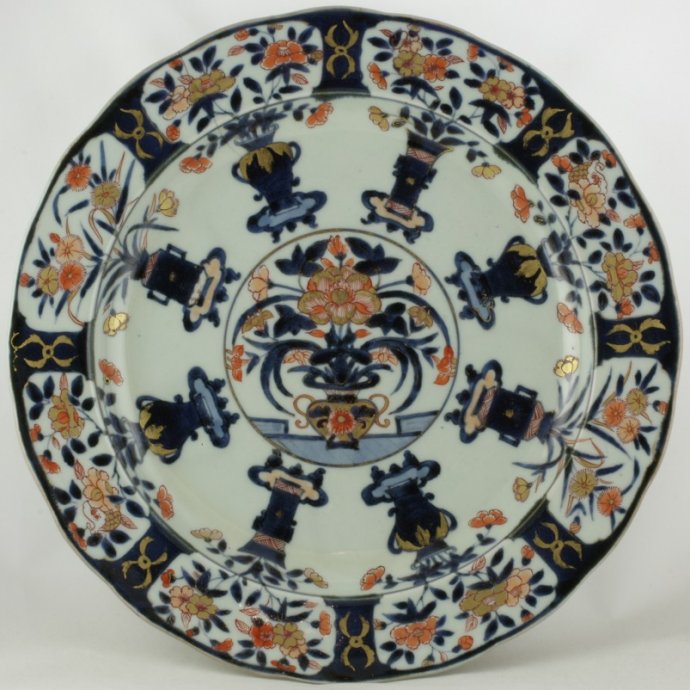
Sold Ceramics - Sold Japanese Imari 1690-1800 - Dishes - Page 2
Object 2012134
Dish
Japan
1700-1720
Height 52 mm (2.05 inch), diameter of rim 343 mm (13.50 inch), diameter of footring 176 mm (6.93 inch), weight 1,376 grams (48.54 ounce (oz.))
Dish on footring, flat rim with a scalloped edge. On the base five spur-marks in a X-pattern. Imari, decorated in underglaze blue, iron-red and gold. In the central medallion a flower vase with shaped handles filled with various flowers on a terrace. The sides with eight flower vases with shaped handles filled with various flowers on low jardinières. On the rim eight reserves filled flower sprays on an underglaze dark blue ground with foliate scrolls in gold. On the reverse three flowering branches - one of peony, one of chrysanthemum and one of prunus. Round the foot a lozenge-pattern border.
The scalloped edge on this dish is unusual for this period rarely seen on dishes of this size.
For a similarly decorated dish, please see:
Condition: A hairline to the rim.
Reference:
Price: Sold.

Sold Ceramics - Sold Japanese Imari 1690-1800 - Dishes - Page 2
Object 2012646
Dish
Japan
1700-1730
Height 41 mm (1.61 inch), diameter of rim 212 mm (8.35 inch), diameter of footring 116 mm (4.57 inch), weight 427 grams (15.06 ounce (oz.))
Dish on footring, straight rim and slightly spreading edge. On the base five spur-marks in a Y-pattern. Imari, decorated in underglaze blue, iron-red and gold with a jardiniere filled with camellia surrounded by a blue band with scrolls in gold. On the sides two half kiku-flower motifs in brocade style, a branch of flowering peony and a bunch of flowers including chrysanthemums. The rim with karakusa scrolls divided by six single cherry blossoms. The reverse with three prunus branches.
The dish belonged to an identical bowl with a cover, both now lost.
The half kiku-flower, here alternately painted in gold and dark blue with a geometric pattern and a gold spray on white, is a common motif and was probably derived from embroidered Japanese textiles.
For an identically decorated bowl with cover and saucer, please see:
Condition: Perfect.
Reference:
Price: Sold.
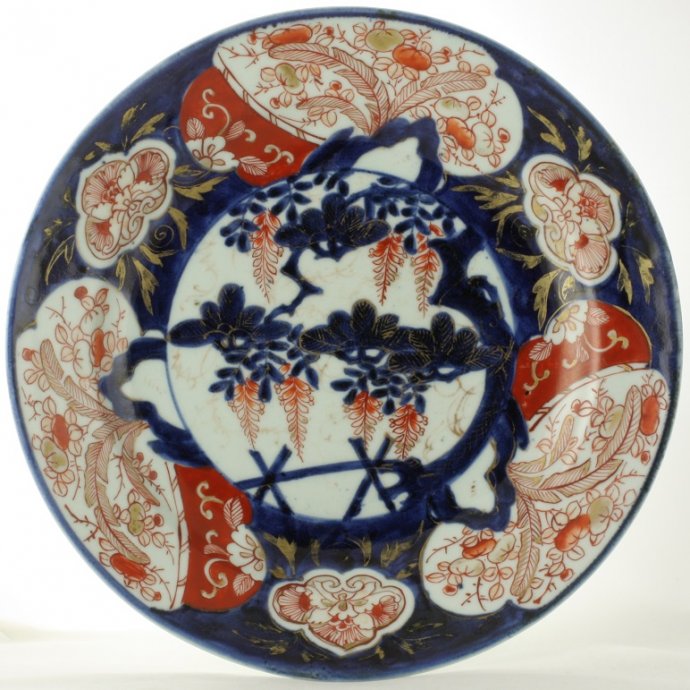
Sold Ceramics - Sold Japanese Imari 1690-1800 - Dishes - Page 2
Object 2011511
Dish
Japan
1700-1720
Height 49 mm (1.93 inch), diameter 294 mm (11.57 inch), diameter of footring 146 mm (5.75 inch), weight 830 grams (29.28 ounce (oz.))
Dish on footring, flat rim. On the base three spur-marks. Imari, decorated in underglaze blue, iron-red and gold with a fence and a flowering wisteria tree. On the sides and rim on a blue ground with foliate scrolls in gold three wide and three narrow panels containing flowering peony and palm leaves alternating with flowering peonies. The reverse with three chrysanthemum sprays.
At the end of the 18th century Dutch porcelain manufacturers Loosdrecht en Amstel Porcelain copied Oriental porcelain designs probably as replacements for broken objects from existing Chinese or Japanese services. Amstel porcelain copied this specific Japanese Imari design at the end of the 18th century. (Jörg 2003/1, p.105), (Jörg 1983, p.32)
For a similarly decorated large dish, please see;
For a similarly decorated Amstel porcelain dish, please see;
- Oosters porselein. Delfts aardewerk. Wisselwerkingen, (C.J.A. Jörg, Groningen, 1983), p.148, cat 159.
- Fine & Curious: Japanese Export Porcelain in Dutch Collections, (C.J.A. Jörg, Hotei Publishing, Amsterdam 2003), p.105, Fig. 108b.
Condition: Some wear to the decoration.
References:
Ayers, Impey & Mallet 1990, cat. 324
Jörg 2003/1, cat. 108 & Fig. 108b
Price: Sold.
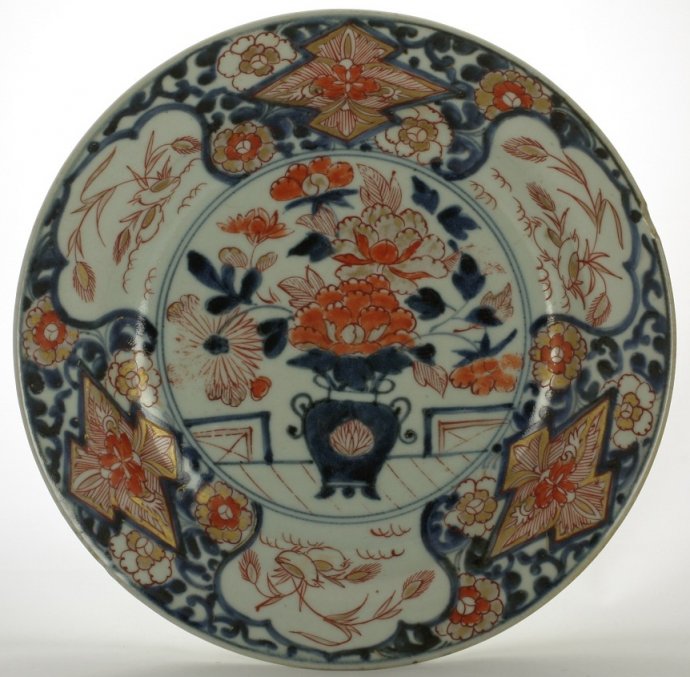
Sold Ceramics - Sold Japanese Imari 1690-1800 - Dishes - Page 2
Object 2010143
Dish
Japan
1700-1720
Height 42 mm (1.65 inch), diameter: 268 mm (10.55 inch), diameter of footring: 140 mm (5.51 inch), weight 706 grams (24.90 ounce (oz.))
Dish on footring, flat rim. On the base four spur-marks in a Y-pattern. Imari, decorated in underglaze blue, iron-red and gold with a vase on a veranda filled with flowering peonies. On the underglaze blue rim scrolls of leafy branches with peony flower heads and three lantern-shaped motifs filled with flower heads and three panels filled with two quails. On the reverse three wide spread prunus blossom sprays.
The quail, or a pair of quails, fairly often used as a motif on fine porcelain, is a symbol of courage because of its fighting qualities. (Jörg & Van Campen 1997, p.213)
Condition: A firing flaw to the rim.
Reference:
Jörg & Van Campen 1997, cat. 237
Price: Sold.
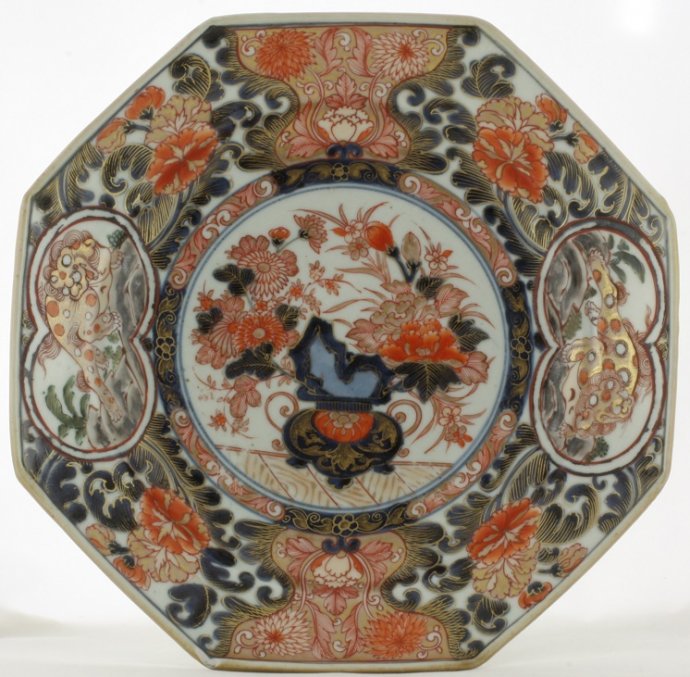
Sold Ceramics - Sold Japanese Imari 1690-1800 - Dishes - Page 2
Object 2010931
Dish
Japan
1700-1720
Height 50 mm (1.97 inch), diameter of rim 285 mm (11,22 inch), diameter of footring 147 mm (5.79 inch), weight 894 grams (31.54 ounce (oz.))
Octagonal dish on footring, flat rim with slightly upturned edge. Four spur-marks in a Y-pattern on the base. Imari, decorated in underglaze blue, iron-red, gold and black and green enamel with a jardiniere (hanakago-de) on a veranda filled with flowering peony and chrysanthemum plants surrounded by a narrow border with florets between scrolls alternating with leafy scrolls. The sides and rim with two shaped panels filled with a shishi and two panels with flowering chrysanthemum sprays in between the panels peony flower heads and leafy scrolls in underglaze blue ground and gold. On the reverse three chrysanthemum sprays. On the base a single, concentric band. To the base an old paper collectors label that reads: '40'.
The "Chinese lion" or kara shishi is supposed to be the Chinese conception of a creature never seen in China but told of by travellers or copied from the pictures from India as there are no records of lions in ancient Chinese writings before about 250 A.D. It is also called a Chinese Dog or Dog of Fo (Buddha) from which it is clear that dog-like characteristics prevail over the original leonine ones. The lion symbolizes guardianship and protection, from which belief is derived the practice of placing statues of lions at the doors of palaces and tombs as guardians of both the living and the dead against all evil.
The shishi is characterized by a fierce expression, large bulging eyes and curly mane, a bushy tail and curly locks of hair on the legs. Japanese pairs of figures of shishi usually have both animals with an ornamental / brocade ball, whereas Chinese examples usually have one with a ball, the other (female) with a cub. It is clear that the shishi is no ordinary lion, but a mythical beast. It is probable that the lion in this mythical form came over from the Middle East as a guardian figure in Chinese pre-historical times. After the introduction of Buddhism, the shishi retained its function as a guardian, and pairs of these animals were placed on either side of the entrance of temples in China and Japan.
For a large dish decorated in the same style, please see:
Condition: Wear to the black enamel and a chip to the rim.
References:
Arts 1983, pp.79-80 & pp.108-110
Price: Sold.
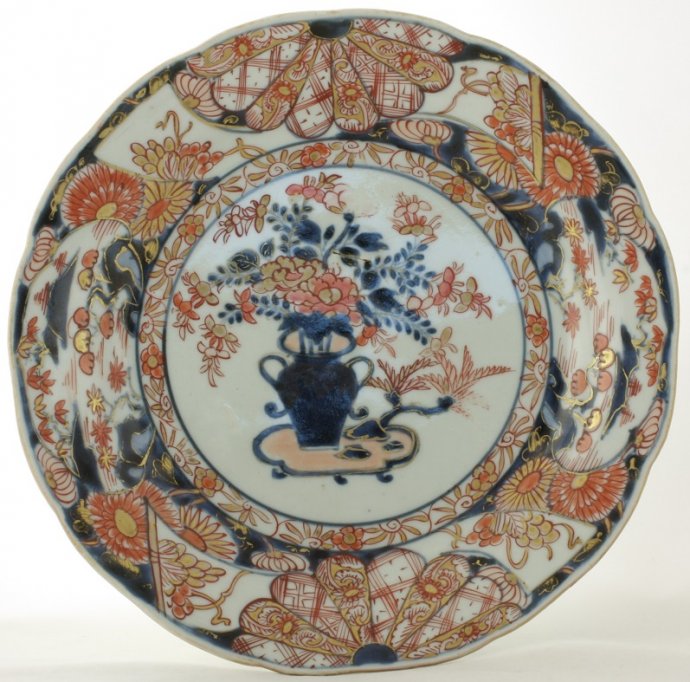
Sold Ceramics - Sold Japanese Imari 1690-1800 - Dishes - Page 2
Object 2011510
Dish
Japan
1700-1720
Height 35 mm (1.38 inch), diameter of rim 252 mm (9.92 inch), diameter of footring 120 mm (4.72 inch), weight 596 grams (21.02 ounce (oz.))
Dish on footring, spreading flat scalloped rim with a glazed base. On the base four spur-marks in a Y-pattern. Imari, decorated in underglaze blue, iron-red and gold with a low jardinière on which a miniature garden with rocks, a small palm tree and a vase filled with flowering peonies and wisterias surrounded by a narrow continuous flower scroll. On the sides and rim a blue ground with chrysanthemums in red and foliate scrolls in gold, two half kiku-flower motifs and four panels, two book-shaped, alternately filled with a riverscape and flowers with ribbons. The reverse with prunus, peony and chrysanthemum sprays.
The book-shaped panels on the sides and rim are unusual and together with the half kiku-flower motif most likely derived from (embroidered) Japanese textile designs. (Jörg 2003/1, pp.106-107 & p.111)
The spur-marks on the base are the remains of pointed supports that pierced the glaze. This was mostly done in Arita, Japan and rarely used in China. After the firing process these attached small supports were hammered of but on this specific dish, two of the original pointed supports are still intact and attached to the base. (Jörg 2011/1, p.248)
For similarly decorated dishes, please see;
- Porzellan aus China und Japan. Die Porzellangalerie der Landgrafen von Hessen-Kassel, Staatliche Kunstsammlungen Kassel, Berlin 1990, p.522, cat. 278a-c.
- Mistrovská dĩla Japonského porcelánu / Masterpieces of Japanese Porcelain, (F. Suchomel, Prague 1997), p.126, cat. 150.
- Fine & Curious: Japanese Export Porcelain in Dutch Collections, (C.J.A. Jörg, Hotei Publishing, Amsterdam 2003), pp.106-107, cat. 110.
Condition: A firing flaw to the centre, some wear to the decoration and fine crazing to the glaze.
References:
Price: Sold.

Sold Ceramics - Sold Japanese Imari 1690-1800 - Dishes - Page 2
Object 2012270
Dish
Japan
1700-1720
Height 38 mm (1.49 inch), diameter 242 mm (9.53 inch), diameter of footring 127 mm (5.00 inch), weight 660 grams (23.28 ounce (oz.))
Dish on footring, flat rim. On the base three spur-marks (one with the cone still intact and attached) in a V-pattern. Imari, decorated in underglaze blue, iron-red and gold with river scape with trees, mountains and clouds surrounded by a narrow border with florets between scrolls alternating with leafy scrolls in gold on an underglaze blue ground. The sides and rim with three shaped panels filled with a bird in flight alternating with three panels filled with a flower head surrounded by leafy scrolls on a underglaze blue ground with flower heads in iron-red and leafy scrolls in gold. On the reverse three prunus sprays.
Condition: Some firing flaws to the rim.
Price: Sold.
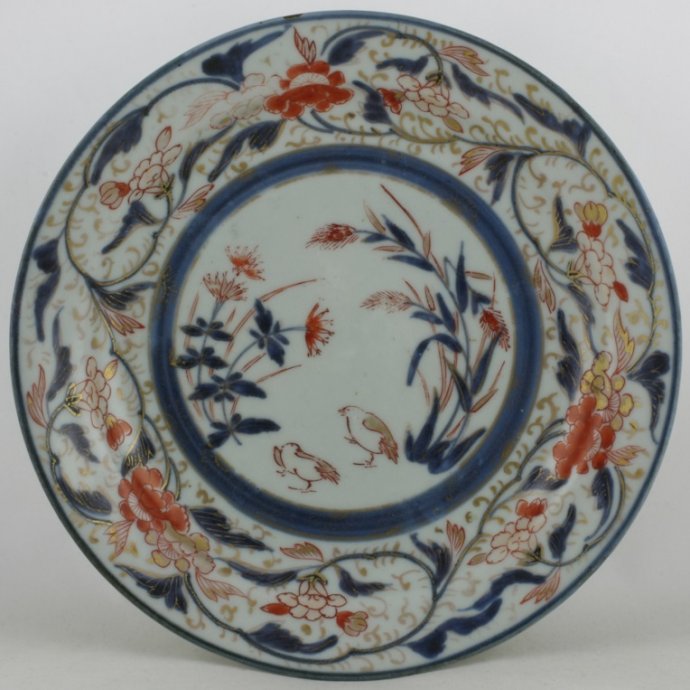
Sold Ceramics - Sold Japanese Imari 1690-1800 - Dishes - Page 2
Object 2011724
Dish
Japan
1700-1730
Height 35 mm (1.38 inch), diameter of rim 219 mm (8.62 inch), diameter of footring 115 mm (4.53 inch), weight 384 grams (13.54 ounce (oz.))
Dish on footring, flat rim. On the base five spur-marks in a X-pattern. Imari, decorated in underglaze blue, iron-red and gold with two quails amongst flowering plants surrounded by a border of half chrysanthemum flower heads in gold on an underglaze blue ground. On the sides and rim leafy and flowering peony scrolls. The reverse is undecorated.
The quail, or a pair of quails, fairly often used as a motif on fine porcelain, is a symbol of courage because of its fighting qualities. (Jörg & Van Campen 1997, p.213)
Condition: A hairline to the rim.
Reference:
Price: Sold.

Sold Ceramics - Sold Japanese Imari 1690-1800 - Dishes - Page 2
Object 2012478
Dish
Japan
1700-1720
Height 31 mm (1.22 inch), diameter 186 mm (7.32 inch), diameter of footring 95 mm (3.74 inch), weight 283 grams (9.98 ounce (oz.))
Dish on footring, flat rim. On the base a single spur-mark with its cone still intact and attached. Imari, decorated in underglaze blue, iron-red, green and black enamel and gold with an opened pavilion in a garden landscape with a flowering tree growing from behind the pavilion and a flowering plant growing from rock work. On the sides and rim four shaped panels filled with bamboo and various flowering plants alternating with flower heads and leafy scrolls on an underglaze blue ground. The reverse is undecorated.
For an identically shaped, sized and decorated dish, please see:
The original Japanese pavilion-pattern was copied by the Worcester factory (1770-1775), see this identically shaped, sized and decorated Worcester dish from a private English collection.
Condition: Perfect.
Reference:
Price: Sold.
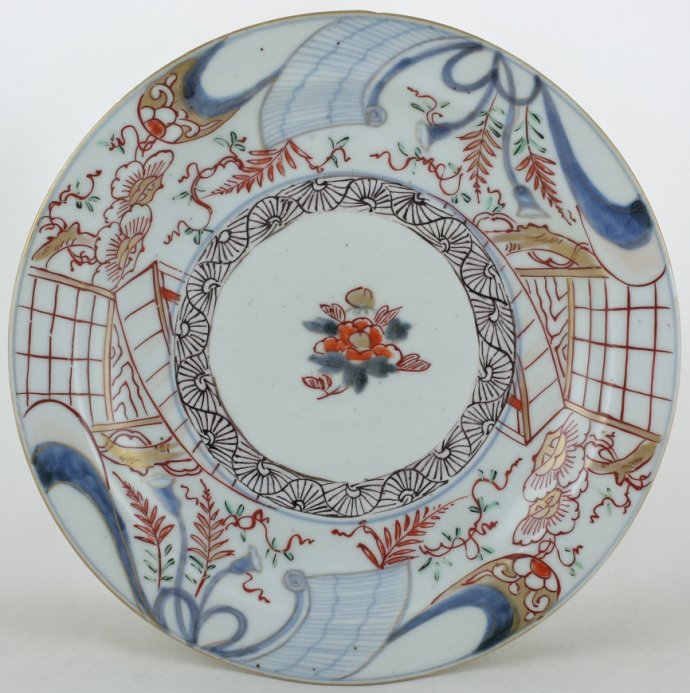
Sold Ceramics - Sold Japanese Imari 1690-1800 - Dishes - Page 2
Object 2012339
Dish
Japan
1700-1720
Height 35 mm (1.38 inch), diameter of rim 219 mm (8.62 inch), diameter of footring 98 mm (3.86 inch), weight 641 grams (22.61 ounce (oz.))
Dish on footring, flat rim. Imari, decorated in underglaze blue, iron-red, gold, green and black enamel. In the centre a chrysanthemum spray in a unglazed roundel filled with a continuous wave pattern. The sides and rim with two wide spread opened curtains tied with strings with tassels and flanked by a peony tree growing from behind a screen on a plank bridge (yatsuhashi). The reverse undecorated.
On sold object 2011818, a shaving bowl, the following was published in Fraeylema Nieuws, number 52, September 2015; 'Most shaving basins are decorated in Imari, but this example was made in one of the smaller kilns which used a different technique, in which the objects were stacked on to each other in the oven while in the middle of the shaving basin, in the glaze, a large ring was left unglazed in order to prevent that the objects would stick to each other during the firing process. That ring is sometimes quite visible, on this object it is subtly hidden in the decoration in enamel colours.'
Condition: Two firing flaws to the rim.
Price: Sold.
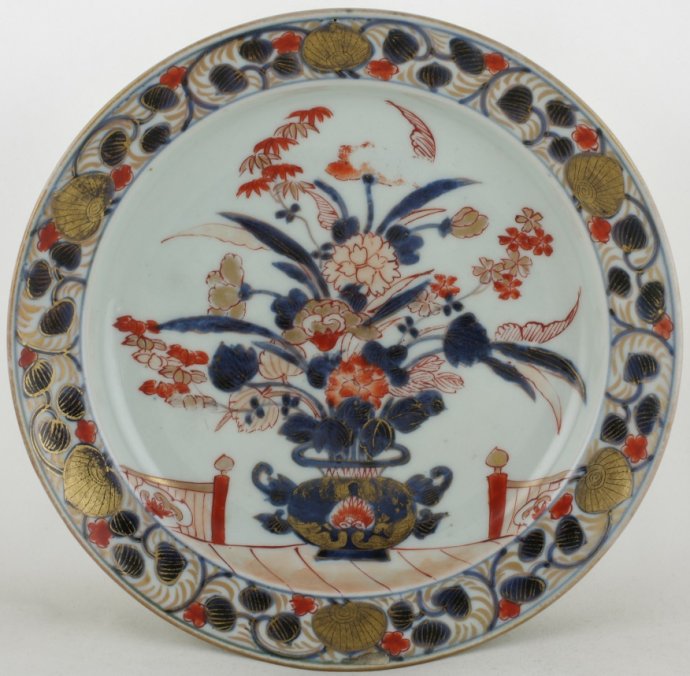
Sold Ceramics - Sold Japanese Imari 1690-1800 - Dishes - Page 2
Object 2012349
Dish
Japan
1700-1720
Height 35 mm (1.38 inch), diameter 215 mm (8.46 inch), diameter of footring 114 mm (4.49 inch), weight 401 grams (14.14 ounce (oz.))
Dish on footring, flat rim. On the base four spur-marks in a Y-pattern. Imari, decorated in underglaze blue, iron-red and gold with a bronze vase or censer with elaborate foliate handles containing peonies, maple branches and other flowers, flanked by low balustrade fences and sitting on board floor. On the rim an unusual Aoi-mon (Tokugawa-mon) vine arabesque karakusa border. The reverse with three branches of peach blossom. Round the footring three concentric bands and on the base a single concentric band.
For a very similarly decorated dish, please see:
Condition: Some wear to the iron-red decoration.
Reference:
Price: Sold
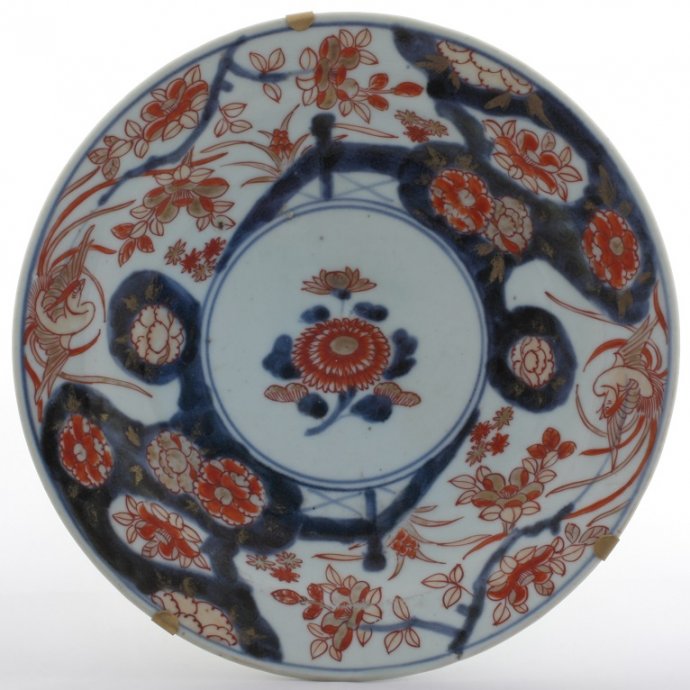
Sold Ceramics - Sold Japanese Imari 1690-1800 - Dishes - Page 2
Object 2010144
Dish
Japan
1700-1720
Height 32 mm (1.26 inch), diameter of rim 245 mm (9.65 inch), diameter of footring 130 mm (5.12 inch), weight 641 grams (22.61 ounce (oz.))
Dish on footring, flat rim. On the base three spur-marks in a V-pattern. Imari, decorated in underglaze blue, iron-red and gold. In the centre a chrysanthemum spray in a roundel. The sides and rim with two panels filled with flowering plants and hõ-õ birds in flight. Peony flower heads are reserved on an underglaze blue ground decorated with leafy scrolls in gold. The reverse undecorated. Fitted in a contemporary brass frame.
Condition: A firing flaw to the rim.
Price: Sold.
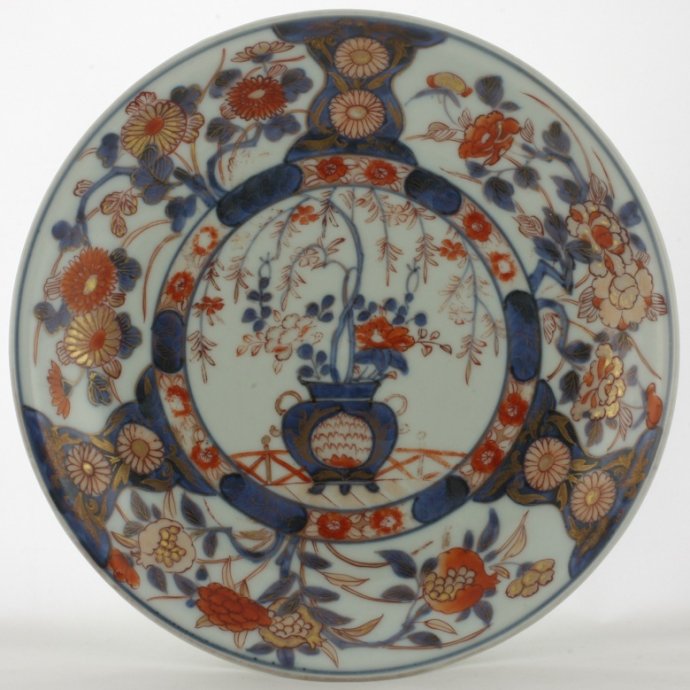
Sold Ceramics - Sold Japanese Imari 1690-1800 - Dishes - Page 2
Object 2010930
Dish
Japan
1700-1720
Height 32 mm (1.26 inch), diameter 220 mm (9.92 inch), diameter of footring 130 mm (5.12 inch), weight 470 grams (16.58 ounce (oz.))
Dish on footring, flat rim. On the base four spur-marks in a Y-pattern. Imari, decorated in underglaze blue, iron-red and gold with a central roundel filled with a vase on a veranda filled with flowering peonies and wisteria encircled by a narrow border with six reserves filles with flowerheads. On the sides and rim three panels decorated with flowering peony, chrysanthemum and pomegranates divided by chrysanthemums flower heads reserved on a underglaze blue ground with leafy scrolls in gold. On the reverse three peony sprays. To the base an old paper collectors label that reads: '6'.
Condition: Perfect.
Price: Sold.

Sold Ceramics - Sold Japanese Imari 1690-1800 - Dishes - Page 2
Object 2010596
Dish
Japan
1700-1720
Height 27 mm (1.06 inch), diameter of rim 218 mm (8.58 inch), diameter of footring 129 mm (5.08 inch), weight 408 grams (14.39 ounce (oz.))
Dish on footring, flat rim. On the base four spur-marks. Imari, decorated in underglaze blue, iron-red and gold with a central roundel filled with a figure standing on in a riverscape with houses trees and mountains surrounded by an underglaze blue border with three reserves filled with flowering scrolls. On the sides and rim three panels decorated with flowering peony, chrysanthemum and pomegranates divided by chrysanthemums flower heads reserved on a underglaze blue ground with leafy scrolls in gold. On the reverse three wide spread prunus blossom sprays.
Condition: Two firing flaws to the rim.
Price: Sold.
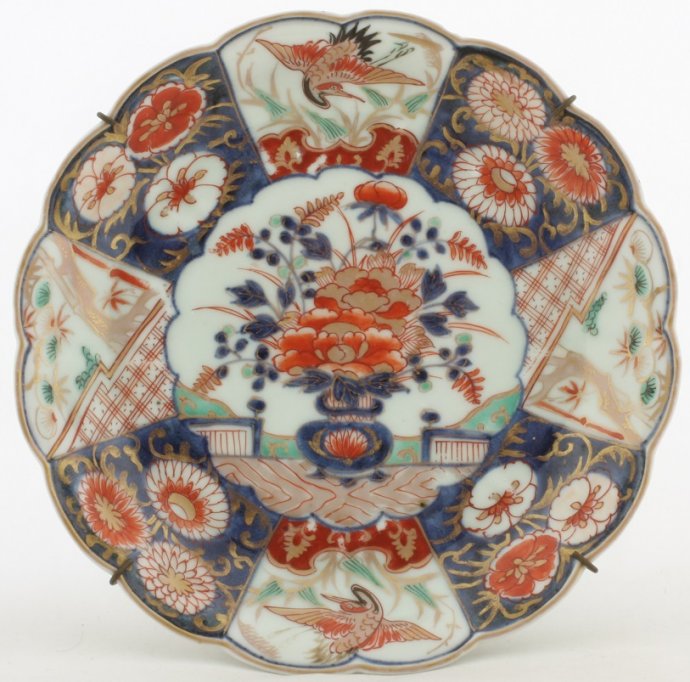
Sold Ceramics - Sold Japanese Imari 1690-1800 - Dishes - Page 2
Object 2011291
Dish
Japan
1700-1730
Height 40 mm (1.58 inch), diameter 222 mm (8.74 inch), diameter of footring 122 mm (4.80 inch), weight 462 grams (16.30 ounce (oz.)), (including brass frame)
Dish on footring, spreading sides and a lobbed rim. On the base two spur-marks. Imari, decorated in underglaze blue, iron-red, green enamel and gold with a flower basket on a fenced terrace filled with a flowering peony and wisteria plants in a lobbed cartouche. On the sides and rim are divided into eight panels, four panels are fillled with foliate scrolls in gold on a dark blue ground with reserved chrysanthemum and peony flower heads, two panels are divided with on one side geometric patterns and on the other side a pine-tree the last two panels are filled with a crane in flight. The reverse with three prunus sprays. Gilt rim. Fitted in a brass frame.
The crane is an auspicious symbol of longevity and a blessed life, a pair of cranes of a long and happy marriage. (Jörg 2003/1, p.185)
Condition: Perfect.
Reference:
Price: Sold.
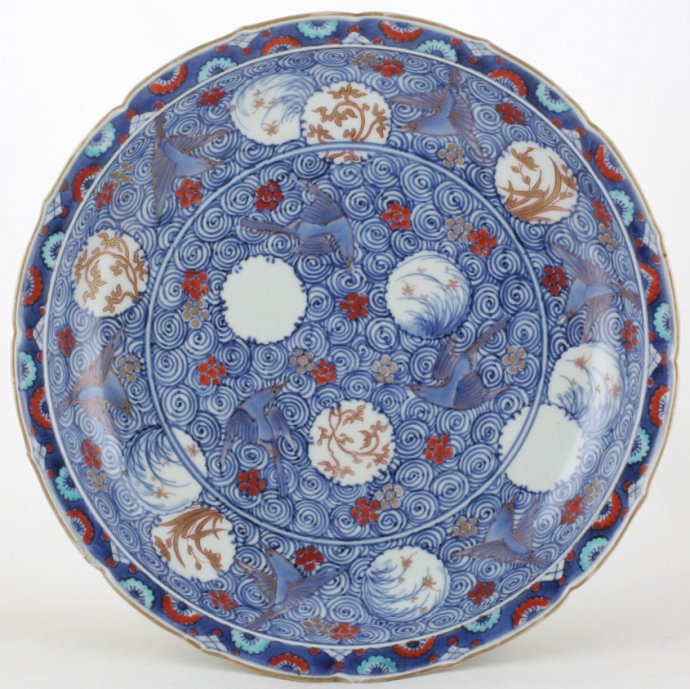
Object 2012370
Dish
Japan
1710-1730
Height 51 mm (2.01 inch), diameter of rim 280 mm (11.02 inch), diameter of footring 158 mm (6.22 inch), weight 880 grams (31.04 ounce (oz.))
Dish on footring, straight sides, short flat rim with an upturned scalloped edge. On the base five spur-marks. Imari, decorated in underglaze blue and overglaze iron-red, turquoise enamel and gold with birds in flight alternaing with roundels filled with flowering plants or left blank on an underglaze blue ground of swirling snowflakes with flower heads in iron-red and gold.
On the sides birds in flight alternating with two connected roundels either filled with a flowering plant or left blank alternating with a single roundel filled with a flowering plant or left blank on an underglaze blue ground of swirling snowflakes and flower heads in iron-red and gold. On the flat rim half flower heads alternate with a lozenge. On the reverse a wide leafy floral scroll with flower heads in iron-red. Round the outer footring a continuous cloud pattern border in iron-red. On the outer footring a double concentric band. Marked on the base with a fuku ('luck') mark within a double-lined square in running script.
The 'fuku' ('luck') mark within a double-lined square (the most common mark, found on Kakiemon pieces), is originally a Chinese commendation mark. Fitski suggests that after 1700, workshops elsewhere in Arita also started to use the mark, but these are less carefully drawn and in some cases they are illegible, spiralling round four times, for instance, instead of three times. (Fitski 2011, p.164)
For an identically decorated, sold, bottle, please see:
The unusual and rare 'swirling snowflakes' design can also be seen on a vase in the collection of the Ashmolean Museum, for this vase please see:
Condition: A frit and chip to the rim.
Reference:
Price: Sold.


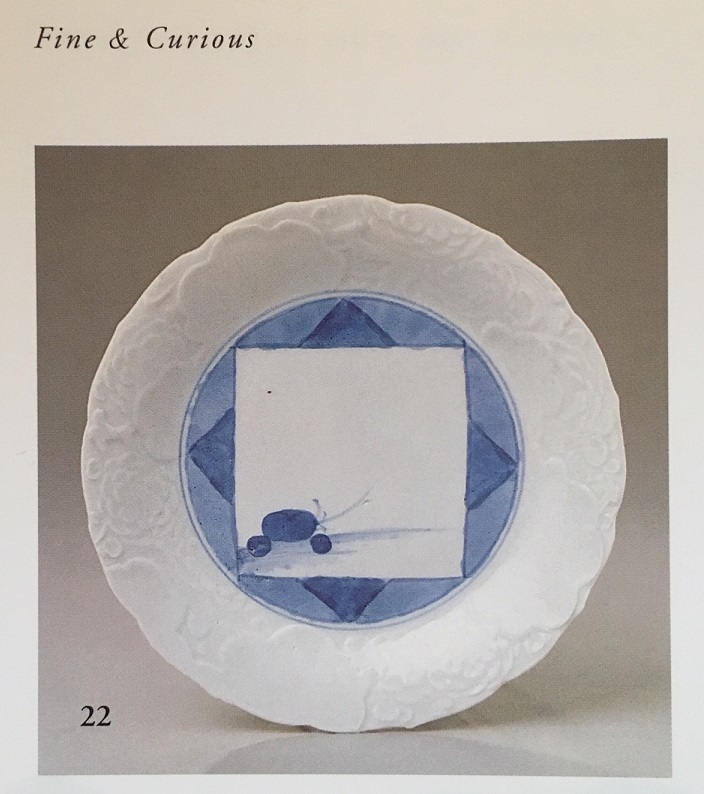
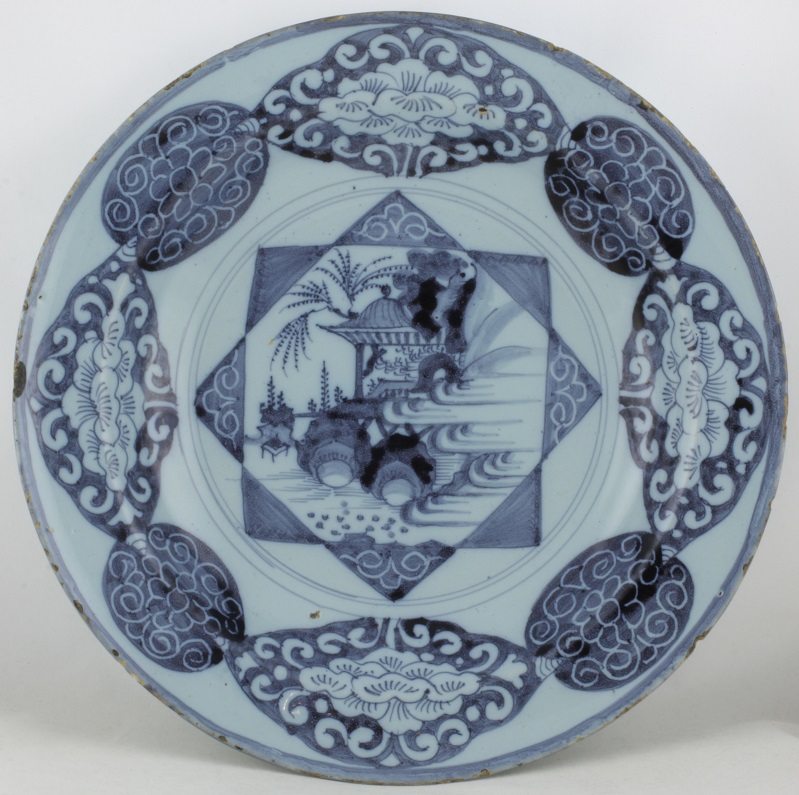
.jpg)
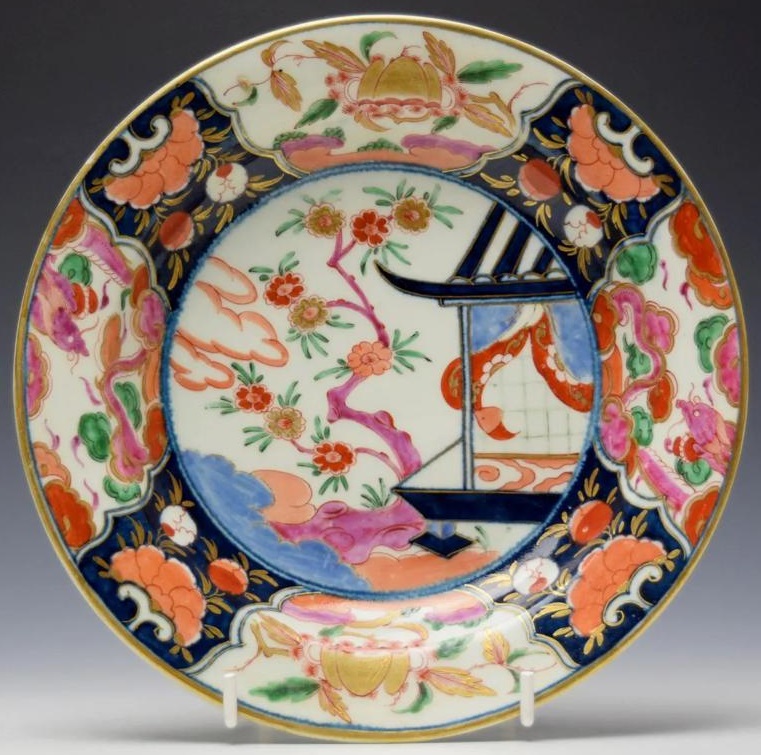
 create websites
create websites